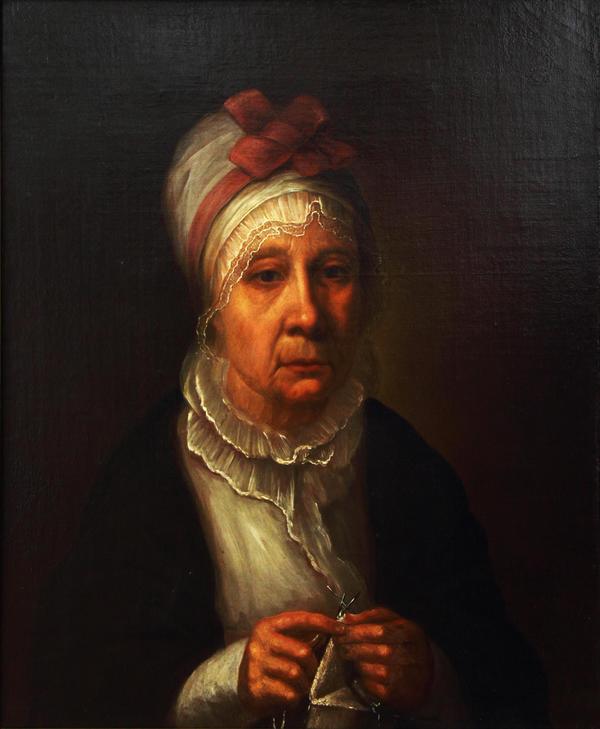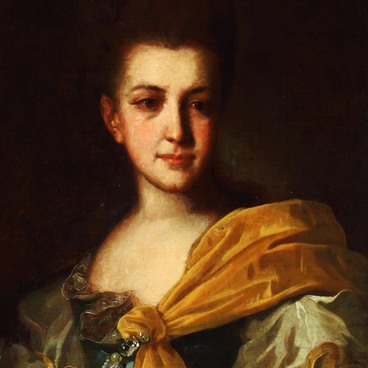This portrait was painted in 1807 and bears the signature ‘I. Shlyakhtenkov’. However, it remains a mystery, who the author of this canvas is. The fact is that at the court of counts Musins-Pushkins in the beginning of the 19th century there were two serf artists Shlyakhtenkovs, Ivan and Ilya, who were brothers to each other.
Moscow art historian Alexei Lebedev established that the heroine of this portrait is Countess Ekaterina Musina-Pushkina. In May 1781, at the age of 26, Ekaterina Volkonskaya married a rich landowner Alexei Musin-Pushkin, who later became a secret advisor and chief prosecutor of the Holy Synod. He became famous as a lover of antiquity, and also found and published The Word of Igor’s Campaign - one of the most important Old Russian literary monuments. In 1797, Emperor Paul I granted him the title of Count.
Like her husband, Musina-Pushkina had a brilliant education and a wide literary outlook. She loved to go public and even in the last years of her life did not deny herself this pleasure. Nevertheless, she was interested not only in idle activities. For the summer, Musins-Pushkins left for the family estate of Ilovna in the Mologa district of Yaroslavl province. Musina-Pushkina was a very powerful woman and took a lively part in economic affairs. Even after the death of her husband, she continued to manage the family’s affairs - despite the fact that by that time, her eldest son Ivan was over 30 years old, and he reached the rank of general.
In this picture, painted by a young serf artist, a peaceful image of Musina-Pushkina in something echoes Pushkin’s image of “old Larina” from the novel Eugene Onegin. The artist has created a convincing type of woman who renounced the transient bustle of life and whose inner gaze plunged into the pictures of the distant past. In real life, Musina-Pushkina was not gentle and almost to death took part in the management of family property. At first, experts suggested that this canvas depicts an old serf nanny, but the portrait similarity, as well as the decoration of clothes and headgear with foreign lace allowed them to establish that this is a portrait of the Countess herself.
Moscow art historian Alexei Lebedev established that the heroine of this portrait is Countess Ekaterina Musina-Pushkina. In May 1781, at the age of 26, Ekaterina Volkonskaya married a rich landowner Alexei Musin-Pushkin, who later became a secret advisor and chief prosecutor of the Holy Synod. He became famous as a lover of antiquity, and also found and published The Word of Igor’s Campaign - one of the most important Old Russian literary monuments. In 1797, Emperor Paul I granted him the title of Count.
Like her husband, Musina-Pushkina had a brilliant education and a wide literary outlook. She loved to go public and even in the last years of her life did not deny herself this pleasure. Nevertheless, she was interested not only in idle activities. For the summer, Musins-Pushkins left for the family estate of Ilovna in the Mologa district of Yaroslavl province. Musina-Pushkina was a very powerful woman and took a lively part in economic affairs. Even after the death of her husband, she continued to manage the family’s affairs - despite the fact that by that time, her eldest son Ivan was over 30 years old, and he reached the rank of general.
In this picture, painted by a young serf artist, a peaceful image of Musina-Pushkina in something echoes Pushkin’s image of “old Larina” from the novel Eugene Onegin. The artist has created a convincing type of woman who renounced the transient bustle of life and whose inner gaze plunged into the pictures of the distant past. In real life, Musina-Pushkina was not gentle and almost to death took part in the management of family property. At first, experts suggested that this canvas depicts an old serf nanny, but the portrait similarity, as well as the decoration of clothes and headgear with foreign lace allowed them to establish that this is a portrait of the Countess herself.



